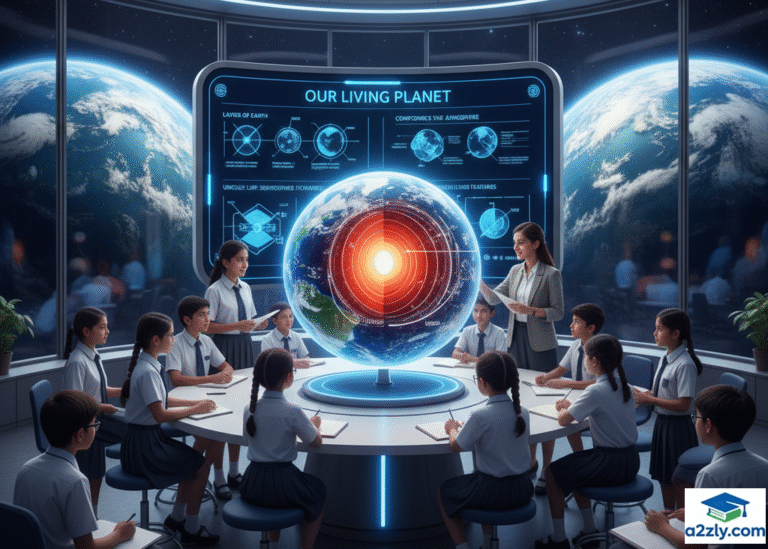🧭 Chapter Overview
Earth — our beautiful blue planet — is more than just our home; it’s a living system that supports millions of species, including us.
From high mountains to deep oceans, from air to soil, everything on Earth is perfectly balanced to sustain life.
This chapter, “Our Home: Earth, a Unique Life-Sustaining Planet”, helps us explore what makes Earth so special — its right distance from the Sun, presence of water, breathable atmosphere, protective magnetic field, and natural balance among all living and non-living components.
Table of Contents
🎯 Learning Objectives (NEP 2025 Competency Table)
| Competency | Learning Outcome | NEP Skill |
|---|---|---|
| Conceptual Understanding | Explain why Earth is unique and supports life | Conceptual Clarity |
| Analytical Thinking | Compare Earth with other planets | Critical Reasoning |
| Scientific Inquiry | Investigate greenhouse effect & water cycle | Inquiry & Exploration |
| Application | Relate balance of nature with human activities | Real-World Application |
| Ethical Awareness | Develop sustainable habits | Values & Environmental Awareness |
🌎 13.1 Why Is Earth a Unique Planet?
Among billions of planets, only Earth is known to sustain life. But why?
Earth has the perfect “Goldilocks conditions” — not too hot, not too cold — just right for life.
If the Earth were an apple 🍎, its crust — where all life exists — would be as thin as the apple’s skin. This thin layer supports forests, oceans, mountains, and every living organism.
Key Reasons Earth Is Unique:
- Right distance from the Sun → moderate temperature.
- Presence of liquid water.
- Atmosphere rich in oxygen and carbon dioxide.
- Protective magnetic field.
- Diverse ecosystems sustaining all life forms.
🌍 Activity: List Features of Earth
Make a list of everyday features of Earth we often take for granted:
- Air that doesn’t escape into space 🌬️
- Water that recycles through the water cycle 💧
- Gravity that keeps everything grounded 🌏
- Oxygen for breathing and carbon dioxide for photosynthesis
These simple but vital features make our planet alive and thriving.
🪐 13.2 What Do the Planets of Our Solar System Look Like?
Our Solar System has eight planets. Let’s compare them briefly:
| Planet | Average Temp (°C) | Atmosphere | Remark |
|---|---|---|---|
| Mercury | 170 | No | No atmosphere, extreme heat & cold |
| Venus | 450 | Yes (CO₂) | Hottest due to thick CO₂ atmosphere |
| 🌍 Earth | 15 | Yes (N₂, O₂, CO₂) | Ideal for life |
| Mars | -60 | Thin | Too cold, lacks liquid water |
| Jupiter | -110 | Yes | Gas giant, no solid surface |
| Saturn | -140 | Yes | Rings, gas-based |
| Uranus | -195 | Yes | Icy giant |
| Neptune | -200 | Yes | Farthest and coldest |
Why Venus Is Hottest:
Venus traps heat through a strong greenhouse effect — CO₂ prevents heat from escaping, making it even hotter than Mercury!
☀️ 13.3 What Makes Earth Suitable for Life to Exist?
Let’s uncover what makes Earth habitable 🌱
1️⃣ Right Distance from the Sun
Earth lies in the habitable zone (Goldilocks Zone) — just the right distance where water remains liquid.
If it were closer → oceans would boil.
If farther → everything would freeze.
This makes Earth’s average temperature (~15°C) perfect for life.
2️⃣ Right Size and Gravity
Earth’s size allows it to have moderate gravity — strong enough to hold the atmosphere, but not so strong that life would be crushed.
If Earth were smaller like Mars, its atmosphere would escape into space.
If larger, gravity would be too high for life to survive.
3️⃣ Atmosphere and Ozone Layer
Earth’s atmosphere contains:
🌬️ 78% Nitrogen
🌬️ 21% Oxygen
🌬️ 0.03% Carbon dioxide
This mixture supports respiration, photosynthesis, and weather balance.
A special layer of oxygen — ozone (O₃) — forms a protective “umbrella,” blocking harmful ultraviolet (UV) radiation from the Sun.
4️⃣ Earth’s Magnetic Field
Beneath Earth’s crust lies molten iron that moves and generates a magnetic field.
This invisible shield protects us from harmful solar wind and cosmic rays.
Without it, our atmosphere could be stripped away — like what happened on Mars.
⚡ Indian Heritage Connection
India’s Mangalyaan (Mars Orbiter Mission, 2013) explored the Martian atmosphere, proving India’s capability in space science and helping scientists compare Earth’s life-supporting features with Mars. 🌕🚀
🌊 13.4 What Allows Life to Be Sustained on Earth?
Life thrives because air, water, sunlight, and soil interact harmoniously.
Let’s see how they work together 👇
🌬️ Air, Water, and Sunlight
- Air (atmosphere) provides oxygen for respiration and CO₂ for photosynthesis.
- Water (hydrosphere) covers 70% of Earth and supports aquatic life.
- Sunlight drives photosynthesis, weather, and energy cycles.
Without this trio, life would cease to exist.
🌱 Soil, Rocks, and Minerals
Beneath our feet lies the geosphere — rich in rocks, minerals, and nutrients.
Soil supports plant growth and provides minerals like nitrogen and potassium, vital for food production.
Different types of rocks and landforms create geodiversity, giving rise to varied habitats — deserts, forests, and mountains.
🌿 Plants, Animals, and Microorganisms
Together, they form the biosphere — the zone of life on Earth.
- Plants produce food through photosynthesis.
- Animals depend on plants and each other for food.
- Microbes decompose waste and recycle nutrients.
Every living organism — from bacteria to elephants — plays a role in nature’s balance.
⚖️ The Importance of Balance
Earth is a complex network.
When we cut forests or pollute air, the balance collapses — affecting rainfall, temperature, and biodiversity.
🌏 Protecting balance = Protecting life.
🧬 13.5 What Keeps Life from Disappearing?
The secret lies in reproduction — the process that ensures continuity of life.
1️⃣ Asexual Reproduction
- Single parent, offspring identical to parent.
- Seen in plants (e.g., money plant, potato, ginger) and microbes (amoeba).
- Simple, quick, but no variation.
2️⃣ Sexual Reproduction
- Involves two parents (male & female).
- Offspring have a mix of traits → variation.
- Seen in flowering plants, animals, and humans.
Variation ensures adaptability — a key to evolution.
🌸 In Plants
- Male part: Anther → produces pollen.
- Female part: Ovary → contains ovules.
Pollination → Fertilisation → Seed → New plant 🌱
🐦 In Animals
- Fertilisation may happen outside (fish, frogs) or inside the body (mammals).
- Mammals nourish their young inside the mother’s body → greater survival.
🌡️ 13.6 What Are the Threats to Life on Earth?
Earth faces a triple planetary crisis:
- 🌍 Climate Change
- 🦋 Biodiversity Loss
- ☣️ Pollution
🔥 Climate Change
Burning fuels → extra CO₂ → more heat trapped → global warming.
Effects:
- Melting glaciers
- Rising sea levels
- Extreme weather
- Threat to food and water
🦜 Biodiversity Loss
Deforestation, urbanisation, and pollution cause species to vanish.
Losing even one species can disturb entire food webs.
🏭 Pollution
Air, water, and soil pollution harm life and environment.
- Air: Causes smog, acid rain, and respiratory diseases.
- Water: Waste kills aquatic life.
- Soil: Chemicals reduce fertility.
🌐 Global Action
International agreements for environmental protection:
- Montreal Protocol (1987): Stopped ozone-depleting CFCs.
- Earth Summit (1992): Promoted sustainable development.
- Paris Agreement (2015): Limit global warming to <1.5°C.
🧠 HOTS (Higher Order Thinking Skills)
- Why can’t life exist on Mercury or Neptune?
- How does the ozone layer protect us?
- How is the greenhouse effect beneficial yet dangerous?
- Why do fish lay many eggs while humans give birth to one baby?
- How do reproduction and evolution help life continue on Earth?
⚙️ NEP Competency Table
| Domain | Competency | Activity Example |
|---|---|---|
| Conceptual | Explain why Earth sustains life | Diagram of life-support features |
| Analytical | Compare planets | Table-based reasoning |
| Practical | Observe plant propagation | Hands-on experiment |
| Creative | Build “Mini Earth Model” | Project work |
| Ethical | Conserve Earth resources | Eco-club initiative |
⚠️ Exam Alert Box
🟢 Short Answer: Why is Venus hotter than Mercury?
🟢 Define: Biosphere, geosphere, hydrosphere.
🟢 Differentiate: Asexual vs Sexual reproduction.
🟢 Long Answer: Explain factors that make Earth habitable.
🟢 Value Question: Why must humans maintain ecological balance?
💡 Memory Booster Box
🔹 Earth = Only planet with liquid water
🔹 Goldilocks Zone = Just right for life
🔹 Ozone layer = Protects from UV rays
🔹 Magnetic field = Shields from cosmic radiation
🔹 Greenhouse effect = Keeps Earth warm
🔹 Triple Planetary Crisis = Climate, Biodiversity, Pollution
📘 Quick Recap
✅ Earth’s right position, size, and atmosphere make life possible
✅ Air, water, soil, and sunlight sustain ecosystems
✅ Reproduction ensures continuity of life
✅ Pollution and climate change threaten the balance
✅ Human responsibility = Preserve and protect our only home 🌍
🔗 INTERNAL & EXTERNAL LINKS
Internal (A2ZLY):
- Chapter 12 – How Nature Works in Harmony Notes 2025
- Class 8 Science All Chapters Smart Notes (2025–26)
- NEP 2025 Science Study Hub | A2ZLY
External:

